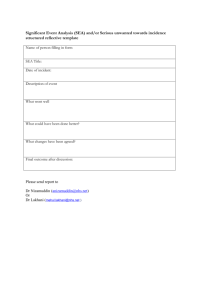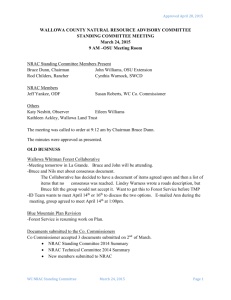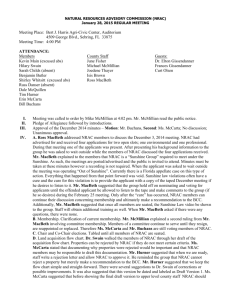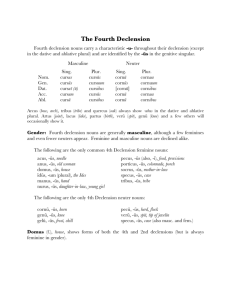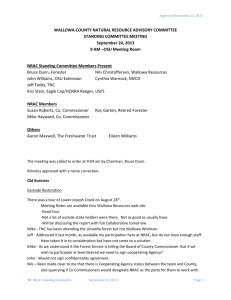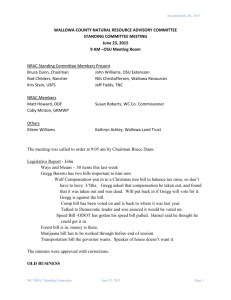1 - TAGRA
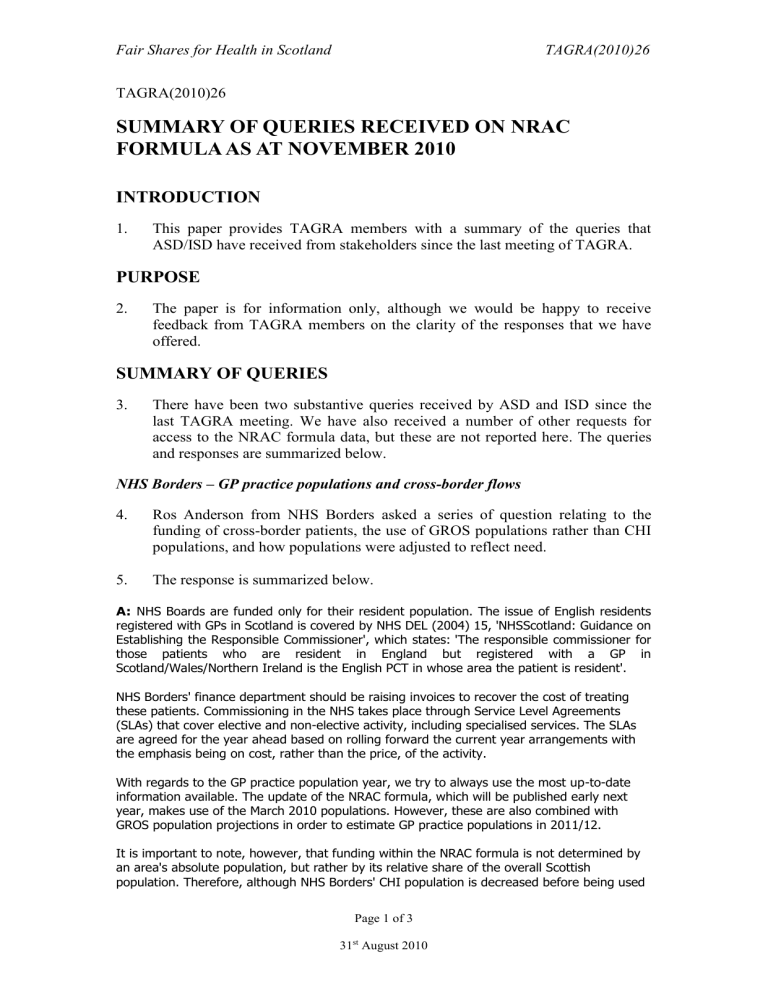
Fair Shares for Health in Scotland TAGRA(2010)26
TAGRA(2010)26
SUMMARY OF QUERIES RECEIVED ON NRAC
FORMULA AS AT NOVEMBER 2010
INTRODUCTION
1.
This paper provides TAGRA members with a summary of the queries that
ASD/ISD have received from stakeholders since the last meeting of TAGRA.
PURPOSE
2.
The paper is for information only, although we would be happy to receive feedback from TAGRA members on the clarity of the responses that we have offered.
SUMMARY OF QUERIES
3.
There have been two substantive queries received by ASD and ISD since the last TAGRA meeting. We have also received a number of other requests for access to the NRAC formula data, but these are not reported here. The queries and responses are summarized below.
NHS Borders – GP practice populations and cross-border flows
4.
Ros Anderson from NHS Borders asked a series of question relating to the funding of cross-border patients, the use of GROS populations rather than CHI populations, and how populations were adjusted to reflect need.
5.
The response is summarized below.
A: NHS Boards are funded only for their resident population. The issue of English residents registered with GPs in Scotland is covered by NHS DEL (2004) 15, 'NHSScotland: Guidance on
Establishing the Responsible Commissioner', which states: 'The responsible commissioner for those patients who are resident in England but registered with a GP in
Scotland/Wales/Northern Ireland is the English PCT in whose area the patient is resident'.
NHS Borders' finance department should be raising invoices to recover the cost of treating these patients. Commissioning in the NHS takes place through Service Level Agreements
(SLAs) that cover elective and non-elective activity, including specialised services. The SLAs are agreed for the year ahead based on rolling forward the current year arrangements with the emphasis being on cost, rather than the price, of the activity.
With regards to the GP practice population year, we try to always use the most up-to-date information available. The update of the NRAC formula, which will be published early next year, makes use of the March 2010 populations. However, these are also combined with
GROS population projections in order to estimate GP practice populations in 2011/12.
It is important to note, however, that funding within the NRAC formula is not determined by an area's absolute population, but rather by its relative share of the overall Scottish population. Therefore, although NHS Borders' CHI population is decreased before being used
Page 1 of 3
31 st August 2010
Fair Shares for Health in Scotland TAGRA(2010)26 in the formula, this does not necessarily disadvantage NHS Borders as a similar adjustment is made to all the NHS Boards.
As you point out, NHS Borders' CHI population as of July 2010 is 116,132. This represents
2.11% of the Scottish list population, which is 5,502,055. By comparison, Within the 2010-11
NRAC formula, NHS Borders' population share for GP prescribing is 2.15%. The two population measures are therefore extremely similar in relative terms, which means that under either approach NHS Borders would essentially receive the same share of funding, even though in absolute terms the populations appear quite different.
There are various reasons as to why NRAC does not use the GP list sizes as its population measure. Firstly, as discussed previously, NRAC is designed to focus solely on Scottish residents, so some degree of list manipulation would be required to achieve a consistent population measure across Scotland. Secondly, NRAC is used for hospital and community services as well as GP prescribing services. As the hospital and community services formula is built up from small areas, use of the GROS small area population estimates makes this side of the formula simpler and more transparent, and it is sensible for both elements of the formula to use a consistent measure of population. Finally, the choice of the population measure was consulted on at the time of NRAC and the majority of respondents felt that there was no better available measure than GROS populations. The full consultation responses are available on the NRAC website at www.nrac.scot.nhs.uk, both in full and in a summary report.
Adult social care budgets – Allocating funds to elderly populations
The IRF team has approached AST asking for information about how the NRAC formula could be applied to allocating resources for the new pooled budget for adult social care for the over 75s. AST provided a number of suggestions:
Options for allocating a Pooled Budget for Older People’s Services
Option1a:
Population
>75s only x age/sex profile x additional needs x
>75s, community only Community only excess costs
Community only
Population shares would be produced based on over 75s only and a new age/sex adjustment created for over 75s, covering all community services. The age/sex adjustment utilises activity and cost data by detailed age bands and so services that are not significant or relevant to older people (e.g. maternity, child health) will be automatically accounted for due to no activity being recorded against the over 75s.
The community index for additional needs and for excess costs would be taken from the overall resource allocation formula and is calculated for all ages.
Option1b:
Population
>75s only x age/sex profile x additional needs x
>75s, community only No adjustment (x1) excess costs
Community only
As with Option 1a, population shares and the age/sex adjustment would be produced based on over 75s only, and the excess cost community index would be used.
Page 2 of 3
31 st August 2010
Fair Shares for Health in Scotland TAGRA(2010)26
The difference for this option would be that the additional needs index would be set to 1, so that no adjustment is made. The additional needs index is calculated for all ages and data availability is limited to be able to determine whether different age groups are differently affected by life circumstances. Of particular concern for this paper, the final additional needs index in the resource allocation formula is significantly influenced by the standardised mortality ratio for 0-
74 year olds, thereby specifically excluding the age group that this allocation is intended to impact on. As a result, it may be preferable not to adjust for additional needs in this specific circumstance.
However, the additional needs index is potentially a sensitive area and it may be judged that its inclusion is necessary for acceptance by all NHS Board areas.
Option 2:
Population
>75s only x age/sex profile x
>75s only
Specific community activity only
(e.g. district nursing) additional needs x
No adjustment (x1) excess costs
Specific community activity only
(e.g. district nursing)
This option tries to pick out individual services, or combinations of services, that may be funded/impacted by any additional allocations as part of the pooled budget. For example, it may be that district nursing is a service primarily targeted to the over 75s population and that this could act as a proxy for the need in each NHS Board area. The full list of community data used in the resource allocation formula is attached in Appendix 1. This approach assumes that all
Board areas would be targeting similar service provision with the pooled funds.
CONCLUSIONS
6.
We would welcome any comments from TAGRA members both on the responses given to the queries outlined above and also on the worth of continuing with this paper as a regular item at future TAGRA meetings.
Health Analytical Services Division
Health Directorates
August 2010
Page 3 of 3
31 st August 2010







